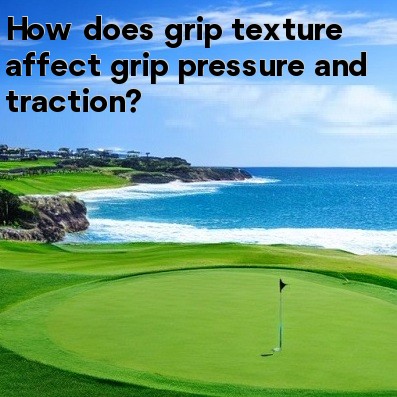
Grip Texture and its Effects on Grip Pressure and Traction in Golf
Golf is a sport that heavily relies on the player's ability to maintain a consistent grip on the club throughout the swing. The grip texture of a golf club plays a crucial role in determining the grip pressure and traction the player can achieve. Let's delve into how grip texture affects these elements.
Grip Pressure
The grip pressure refers to the force applied by the player's hands on the club during the swing. The grip texture of a club can have a significant impact on the grip pressure.
A rough or aggressive grip texture can often lead to a higher grip pressure. When the surface of the grip is uneven or coarse, the player tends to grip the club tightly to maintain control. This increased pressure can create tension in the hands and forearms, which may affect the fluidity and tempo of the swing. Additionally, excessive grip pressure can reduce the player's sensitivity to the club's feedback, resulting in compromised shot quality.
On the other hand, a smoother and softer grip texture promotes a lighter grip pressure. The smooth surface allows the hands to remain relaxed, reducing tension and providing better awareness of the club's movement. With a lighter grip pressure, players can achieve greater hand and wrist freedom, resulting in a more effortless and consistent swing.
Traction
Traction refers to the grip between the player's hands and the club, ensuring control and stability during the swing. The grip texture plays a vital role in determining the level of traction.
A golf club with a coarse or textured grip offers improved traction. The uneven surface creates friction between the hands and the club, allowing players to maintain a secure grip even in adverse weather conditions or when their hands get sweaty. This enhanced traction contributes to better control over the club, reducing the risk of slipping or mishitting the ball.
Conversely, a smoother grip texture may provide less traction. Particularly in wet conditions, a smooth grip can become slippery, making it challenging to maintain a stable grip on the club. In such situations, players must adjust their grip pressure to compensate for the reduced traction, which can impact their swing dynamics and overall performance.
Choosing the Right Grip Texture
When selecting a golf club grip, players should consider their personal preferences, playing style, and typical weather conditions. Golfers who prefer a lighter grip pressure and require greater sensitivity to the swing may opt for a smoother texture. Conversely, those seeking maximum traction and control may prefer a more textured grip.
It is important to note that grip texture is not the sole factor influencing grip pressure and traction. Factors such as hand size, club material, and grip thickness also play significant roles. Thus, golfers may need to experiment with various grip textures to find the one that best suits their needs and enhances their overall performance.
In conclusion, grip texture in golf clubs has a direct impact on grip pressure and traction. A rough or aggressive grip texture may increase grip pressure, while a smoother texture promotes a lighter grip. Similarly, a more textured grip provides better traction, whereas a smoother surface may lead to reduced traction. Ultimately, golfers must find the right balance of grip pressure and traction for optimal performance on the course.





